Meet Giulia Blocal Riva, a Street Art Expert Who Pens Books, Organizes Festivals, and Leads Tours in Rome and Beyond
Issue #126
In Rome, ancient monuments and Renaissance and Baroque art tend to steal the show, but according to
Riva, the city was one of Europe’s original street art hotspots. She would know: growing up here in the ‘90s, she witnessed the medium’s rise and has been writing about it for more than a decade for various publications as well as her own blog, BLocal, and Substack newsletter, . She also works with street art festivals, museums, and galleries.I actually edited a couple of pieces Giulia wrote about Rome for Untapped Cities over ten years ago, but we didn’t meet in person until last year, when she led me and fellow writer
on a street art tour of San Lorenzo. On that tour, Giulia led us all around the neighborhood, telling us the stories behind street art pieces both large and small, from wheat paste stickers to enormous murals that span the walls of whole buildings.Giulia is currently working on a series of self-published books focused on street art in various cities. Her first book, As Seen on the Streets of Paris came out in December. In addition to offering private walking tours in Rome, she also brings small groups to Europe’s street art capitals to get a behind-the-scenes peek as she gathers material for her books. I’m thrilled to share her insights as part of my series of interviews with entrepreneurs and creatives doing cool things in Italy.
So Giulia, you grew up here in Rome, right?
I was born on Tiber Island and I'm very proud of it. When I was born, I was living in a very residential area called Casetta Mattei. Then with my parents, we moved to Prati when I was in primary school. I grew up there, but I chose to go to high school in another neighborhood, and that's how I started discovering the city.
That was the whole point, because if you lived here as a teenager, especially back then without the internet or social media, everything was very related to the school where you were going or the neighborhood where you grew up. I wanted to avoid studying in my own neighborhood because I thought it's a very boring neighborhood. So I picked a school where there were kids from all over the city, and this gave me the opportunity to explore.
And then when I started university, I started living abroad around Europe. I would come back to Rome on and off. And when I came back, I lived in Monti and—this was a crazy experience—I lived in a Buddhist monastery in Trastevere that was the house of Al Bano and Romina Power. They're very famous singers, but my grandmother listened to them. So Romina Power moved to California and donated this house to this Buddhist temple and I was living there.
And then after the pandemic in 2021, I moved back to Prati. It's not a neighborhood that I would pick if I moved to Rome from abroad or from another city, but it's very convenient for me, because my friends and my family are there.
What did you study and how did you get interested in street art?
I got interested in graffiti and street art when I was a kid, because Rome was one of the graffiti capitals of Europe. So all the trains in the ‘90s were covered with pieces, and also puppets. That is, the kind of characters that writers do next to the graffiti piece. And usually these puppets come from cartoons, or Disney characters, or maybe animals or something.
So for a child, it was very fascinating that we were waiting for the metro, and all the metros were full of colors, and I started taking photos of the graffiti and street art around the city and also while traveling with my parents. I remember I had a kind of a toy camera with a Ninja Turtles stamp on it. So it started as a game. I didn't know what it was or why people were doing it, I didn’t know the artists by name, as I do now. It was just something fun for a kid to watch.
I studied economics and the marketing of art for three years in Rome. But it was not mandatory to go to class, so I lived one year in London, one year in Madrid and one year in Dublin, just doing random jobs and then coming back to Rome to do the exams. And then after these three years of economics, I went to Bologna for a specialization in cultural management.
When and why did you start your blog?
I started, technically, in 2011 although it was something completely different. Back then, I was living in Slovenia and traveling around the Balkans. And as a job, I was organizing tours for Italian music bands that were coming to play in Slovenia, Croatia, Serbia. So I was traveling a lot, and the first idea of the blog was to write about these road trips across the Balkans. So it had nothing to do with street art. It was about alternative travel, alternative places, because we were going to play in squat places. So it was that kind of underground scene, but it had nothing to do with art.
And then I moved back to Italy. I was living in Turin and working for Paratissima, which is an alternative art fair that happens at the same time as Artissima. There I started working more with visual artists, and some of them were also street artists. So I kind of reconnected to that because I always liked it; I was just not writing about it. Eventually I started writing more and more about street art, because the whole idea of BLocal is to live somewhere for a few years or a few months, then write about that city from the point of view of a local.
I slowly realized that most of the places that were ending up in my blog were also places where street art was thriving back then, and that's how the two connected, because I didn't want just to put a picture, I wanted to, at the very least, write the name of the artist. But it was not like now, when everybody's on Instagram self promoting their art. You had to do a bit of investigation to find out who it was. So that's part of the curiosity.
How does the street art scene in Rome compare with the scene in other cities? Because I think a lot of outsiders don't necessarily associate Rome with street art. I mean, the typical tourist thinks about all the Baroque art and Michelangelo.
For sure, there is something to see beyond Baroque art and Michelangelo in Rome. But personally, it's not one of my favorite scenes. I find it a bit stale and dead compared to other cities. It's ironic because the first exhibition of graffiti art—meaning like graffiti on canvas—outside of New York was in Rome in 1979, so we started on the right foot, but now it's very sad and dead. I don't know if it's something specific to Rome, but for example, if you go now to a graffiti jam Rome, all the people painting there are around 50 years old with white hair, there aren’t any new kids painting. But it might be more of a generational thing.
Who are some of the key street artists here in Rome? If people are walking around, what should they look for?
There are many. One that I really like, and I also work with her, is Alice Pasquini. She's one of the first female street artists from Italy, and her work is well recognized all around the world. She travels all around to paint murals, but she lives in Rome. But again, she paints very rarely in Rome, like maybe sometimes she does a little spontaneous intervention in her neighborhood, just because, but she paints more often in other cities than here.
We saw some of her work in San Lorenzo.
Yes, that's a very, very old one.
She also did something inside of that hotel...
Chapter Roma. I really like her work. There are also a lot of cool poster artists that are active in Rome, like Merioone. He's very active all around Europe, but he's from Rome, so of course, you will find many pieces. There’s a duo that I like a lot called Sten & Lex, and they are also among the pioneers.
But again, they are not very active—not as much as before. Maybe it's also a kind of aging thing, because they work a lot for galleries now in the contemporary art scene, not just in the street. There's still doing things, but not as many as before, which is understandable, because if you started 20 or 30 years ago, you also want to change. Otherwise, you're not an artist, if you're doing the same thing over and over again. The problem is that there is not a new generation.
You've written about the legality of street art for your newsletter and your blog. So is it legal here in Rome? How does it work in terms of public walls versus private space?
So generally speaking, no, neither graffiti nor street art are legal in Italy, because the law is for the country, not the city. It's very difficult to do commissioned work in Rome because many buildings are protected by UNESCO. You need to ask for a lot of permits. Between 2015 and 2018, I tried to organize some murals with a group of friends. The project was called “Forgotten Project,” and it was super fun, but it was really, really difficult, especially this part, because we wanted to do something that would last and be impactful, and we were working on a specific kind of building, and we would prefer to have it in the city center. So it was very hard to ask for permission.
It was disappointing, because we just wanted a piece of paper and there are a lot of offices that you have to go to and each one was saying, “No, it's not me. You have to go there,” or “Come back here after you get that other paper.” It was really, really complicated. It was amplifying our frustration, because we were trying to do something like a pure act of love. We were not earning anything from it. We were doing it as a team of friends and volunteers, putting in a lot of effort and energy and time. We just wanted to do it, and the municipality was stopping us in many different ways. It’s way easier in small villages. There are a few festivals I work for outside the city, in rural areas. And there it's way easier because everybody knows each other. You know who is the owner of that building.
So the legal part is really, really difficult. And another thing I write often in my newsletters is about commercial murals, and luckily in Rome, we don't have many. There was a Netflix one in Pigneto a few years ago; now they just put on electronic advertising. Now it’s way uglier, but at least I don't feel that they are exploiting the street art movement. There are street artists that are still doing something illegal, especially with mediums such as stickers and posters.
What about the really enormous murals in San Lorenzo? There's that one on the side of the building that depicts all like the immigrants that live in the neighborhood.
San Lorenzo is a fun case study because in San Lorenzo you can find everything. And that's why I often do tours there, because it allows me to explain all the differences between graffiti, posters, street art, urban art and everything. And in San Lorenzo, they created some murals, like the one that you are talking about is a commissioned mural, so it's not illegal. And several murals in San Lorenzo are the result of a bando. So it's the city doing an open call, and they want the mural to be on a specific theme.
There are several ones in San Lorenzo like this, so there is freedom, but it's not really freedom, because you have to do something on that specific theme, otherwise your proposal will not be accepted. And also to apply, you have to submit a sketch. It doesn't have to be the same thing, but still, there is someone approving your sketch and the theme should be what they want to communicate. So it's nice and I really like that specific mural, but it's not the same freedom as spontaneous street art, because there is no one that was telling you the topic or approving a sketch beforehand.
I like that one, because I think that it kind of gives you a little bit of insight into the neighborhood, right?
Yeah, it represents the different souls of San Lorenzo. The artist is Luogo Comune. He is not from Rome, but he won and I like it because it tells the story of the neighborhood in a visual, very engaging way. There are two more murals that are about the bombing, which happened in 1943, so it's many years ago, but it's still very strong in the identity of the neighborhood. So it's also about history.
A lot of murals can be about history, which is also interesting, because when you travel, you don't necessarily know everything about the city you’re visiting, and this is a nice way to find out, but it's also interesting for locals and residents, because they discover something about their area.
Where else do you do tours here in Rome?
My tours are all private and tailor made, so it depends on what the person wants to see besides street art. When they reach out to me, I always ask, what else do you like? Do we want to mix it with architecture, street food, politics, history, vintage shops, whatever.
And then, according to their preferences, I try to create an itinerary so it can be either the eastern part or the southern part. The west is more difficult, it’s more for people who want to see specific walls, and also Rebibbia because there are several murals that are very scattered, so it's not easy to go to, but for people that are passionate about street art, and they've seen already what you can reach with the metro, sometimes we go to more far away areas.
When you say the eastern and the southern parts of Rome, you mean like Pigneto and Ostiense?
Being tailor made, the length is variable, so for a maximum length let's say the east will start in San Lorenzo, and then it's Pigneto, Maranella, Centocelle, Tor Marancia, that area up to MAAM, which is only open on Saturday.
MAAM is an abandoned factory from Fiorucci, so they were making salami, and it was squat, and now many migrant families live there. So that's why it's not open to the public every day, because there are families with kids, but they want to have some communication with the city, and also to have people going there to see their reality.
And so it's open every Saturday and it's kind of the urban art museum of Rome, in a way. That's what some people call it. But since I worked at STRAAT and other street art museums, that's not what I consider a museum. It's a completely different project, because it's more organic, which is a good thing. It's a place where many street artists have painted, invited by Giorgio De Finis, who, after that, curated MACRO, which is the main contemporary art museum of Rome.
Then the southern area is from Testaccio down to Ostia if we really have a lot of time. I love Ostia.
You are also doing multi day tours in other cities, right? Can you tell me a little bit about that?
That's something that started last year, and I really love it. It started as a way of funding the books that I'm writing about those cities, which is our independent, self-published project. Because I do write as a copywriter of street art books for publishers, but this is my baby, just my own project, and the photos are by my boyfriend. So it's our thing, and to raise the money to pay the graphic designer and the platform on which we self publish, and all the expenses, we organized a tour in Paris.
It was super fun to meet the readers of my blog and explore different cities together, so we did it in more cities. And these tours are like the blog, but in real life, because we are going to have the same experience that you can read on my blog when I visit a city. I consider it my blog in 3D.
The groups are very small, like four, five people. I want to be able to spontaneously enter a restaurant or a cafe, because we want to stop for a while, and if you are 12 people, you are either divided in different tables or it can be a problem during peak lunch or dinner. So my idea of a group is that we can comfortably sit around a table and have a coffee and start again, because they're kind of marathons. They're from early in the morning to late evening and then the day after, you start again with a different neighborhood.
And the goal for me, apart from this social experience and meeting people in real life, is to collect material for the book. So sometimes we step into art studios and people are there while I do the interview that is going inside the book. And for my boyfriend, the goal is taking photos, so it's also a behind the scenes peek. It's not a tour with the umbrella and people following me.
I have a plan of what I want to see, because I want to add those neighborhoods and those stories in the book. I have appointments with the artists for the interviews, or with gallery owners. In the book, you only see the interviews with the artists, because, of course, they are cool, and you want to know what's the favorite restaurant of that street artist, but I also interview professionals like gallery owners or people that work in the field and that can give me all their insights and knowledge.
So far, you've done Paris and London?
The books, yes. As for the trips, we did Paris, Madrid, London, and Athens. But we are a bit slow in book preparation. So far, there is only Paris, and we are still working on it, because we are trying to make the e-book version. And then we are writing and working on the London one, and then we will see. I mean, for sure, Madrid and Athens.
Then I have the Lisbon trip this year in May, which I'm doing even though I'm like three cities behind on the schedule, but still, I want to go. And there are already people that want to come on the Lisbon trip. There's a guy that came on the Paris trip and a couple that was on the London trip. So it's fun that people want to come back and enjoy different cities with me.
Will you do a Rome book?
I will do a Rome book eventually, but it's way more difficult to write about your own city. It's more difficult to select the artists, because I know them all. And I work with many of them, so I don't want them to think, “Oh, she didn't pick me for the book,” and to be offended. And I'm 40, so I saw different stages of Rome. It's difficult to freeze it in time and give it a fresh kind of neutral perspective.
Of course, I have an opinion, and if people follow me and read my stuff, it's because they want to know my point of view, but my opinion in another city is more contemporary and based on recent experiences. Maybe in Rome there are areas that I have bad feelings about because 20 years ago, something happened, and maybe now the area is completely different, but in my mind, it's still an area of bad memories.
Just to wrap up, you're also vegetarian, right? So can you share some tips about vegetarian food in Rome?
This is something I want to talk a lot about. First of all, I believe that Italian cuisine and Roman cuisine have a lot of dishes that are traditionally vegetarian, and you can find them in many restaurants. And also, if you look at the pyramid of Mediterranean cuisine, at the base is vegetables, and then it's legumes. So even if you are eating meat or fish, you're supposed to eat more beans and legumes than meat and fish.
So I like to find these kinds of dishes in normal restaurants. I don't go to many vegan restaurants in Rome. It's more something that I do when I travel, because especially if I don't know the language, I don't know all the ingredients, and it's easier to just Google vegan restaurants and have that in my map. But in Rome, I like to go to normal restaurants and just order something vegetarian.
Do you have any favorite restaurants in Rome?
Many. So I have an article on my blog that is both favorite restaurants and all these dishes that you can order, and also it's kind of a vocabulary, because my blog is in English, so it's a vocabulary of vegetarian food, and what you can say.
There is one vegan restaurant in my neighborhood that is called Ma Va. And I like it because it serves things like fettuccine with porcini, like pasta with mushrooms. It's not complicated things with weird names and strange ingredients that scare people away. And there is one in Ostia called Status Quo.
And then something that I'm curious about, but I haven't tried: in Parioli, there is a place that has a 3D printer and they print meat. So they haven't killed any animals. I don't know more because I haven't been.
One place I really like, and we go during my tours, is called the Vegustibus. It's in Garbatella. It's not a restaurant, but they have something that you can eat there and they also sell things that you can cook at home. They have vegan mortadella and it's amazing. And also the sweets like croissants and that kind of stuff.
Further Reading
To get to know Giulia better, be sure to check out her blog, BLocal, and subscribe to her newsletter
.To learn more about MAAM, Rome’s Museo dell’Altro e dell’Altrove (Museum of the Other and the Elsewhere), read Giulia’s blog post about it.
You can see Giulia’s guide to the best vegan and vegetarian food and restaurants in Rome here.
I included Giulia and her street art tours in my very subjective list of the best tour guides and companies in Rome.
You can read all of the interviews in this series here.


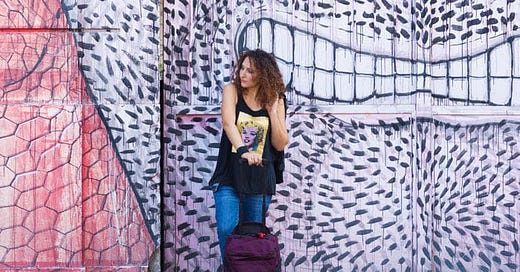




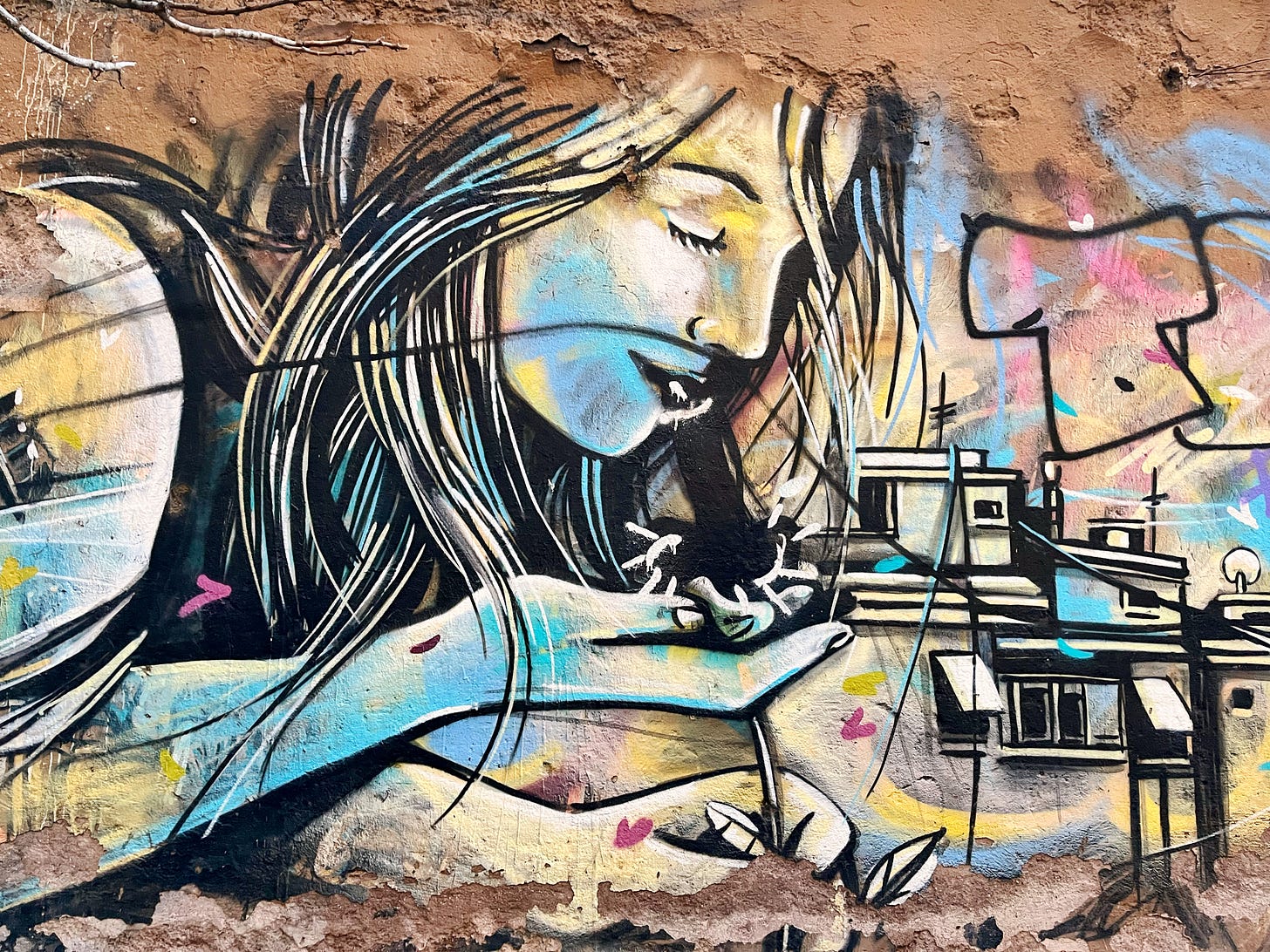
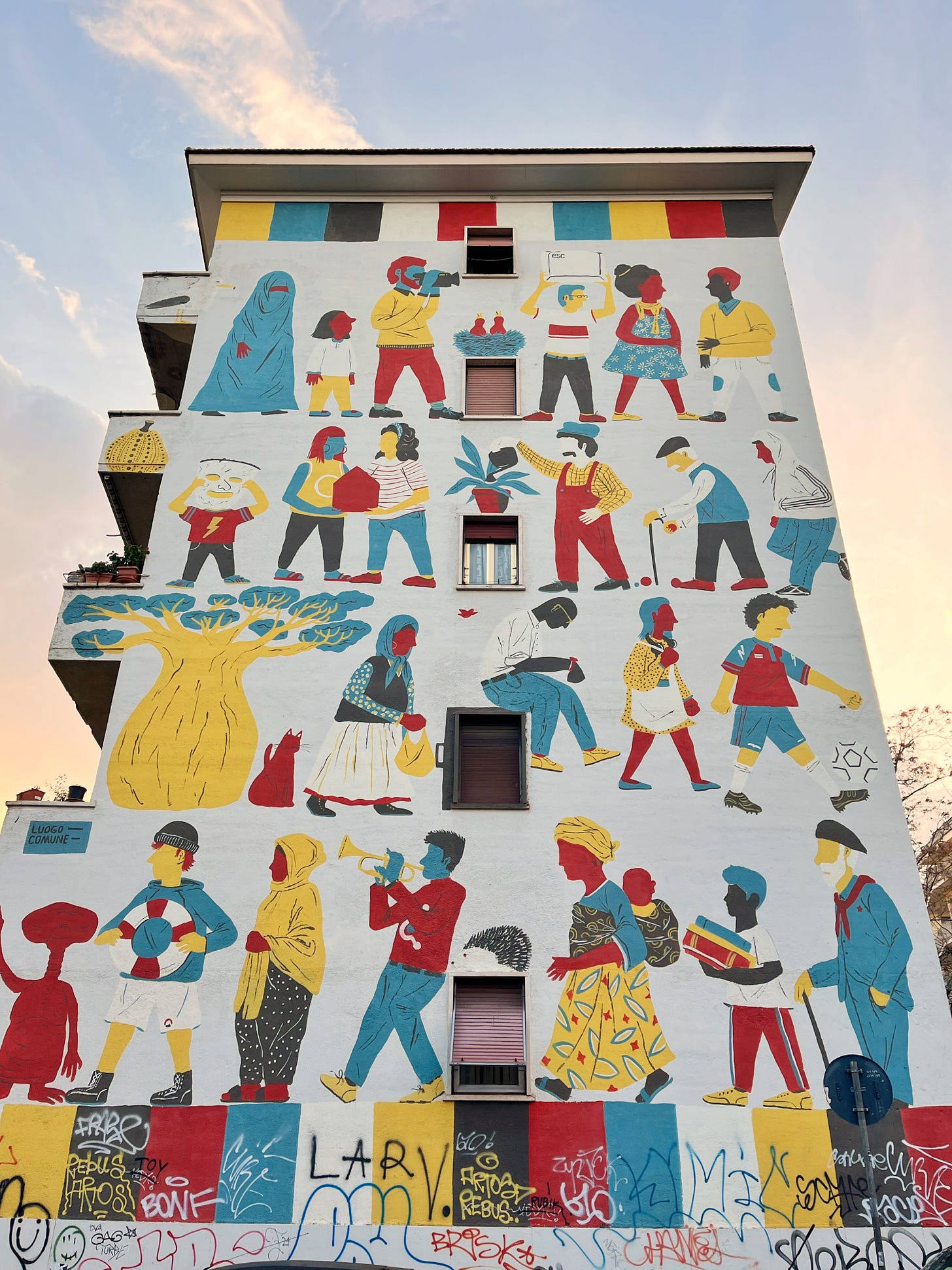

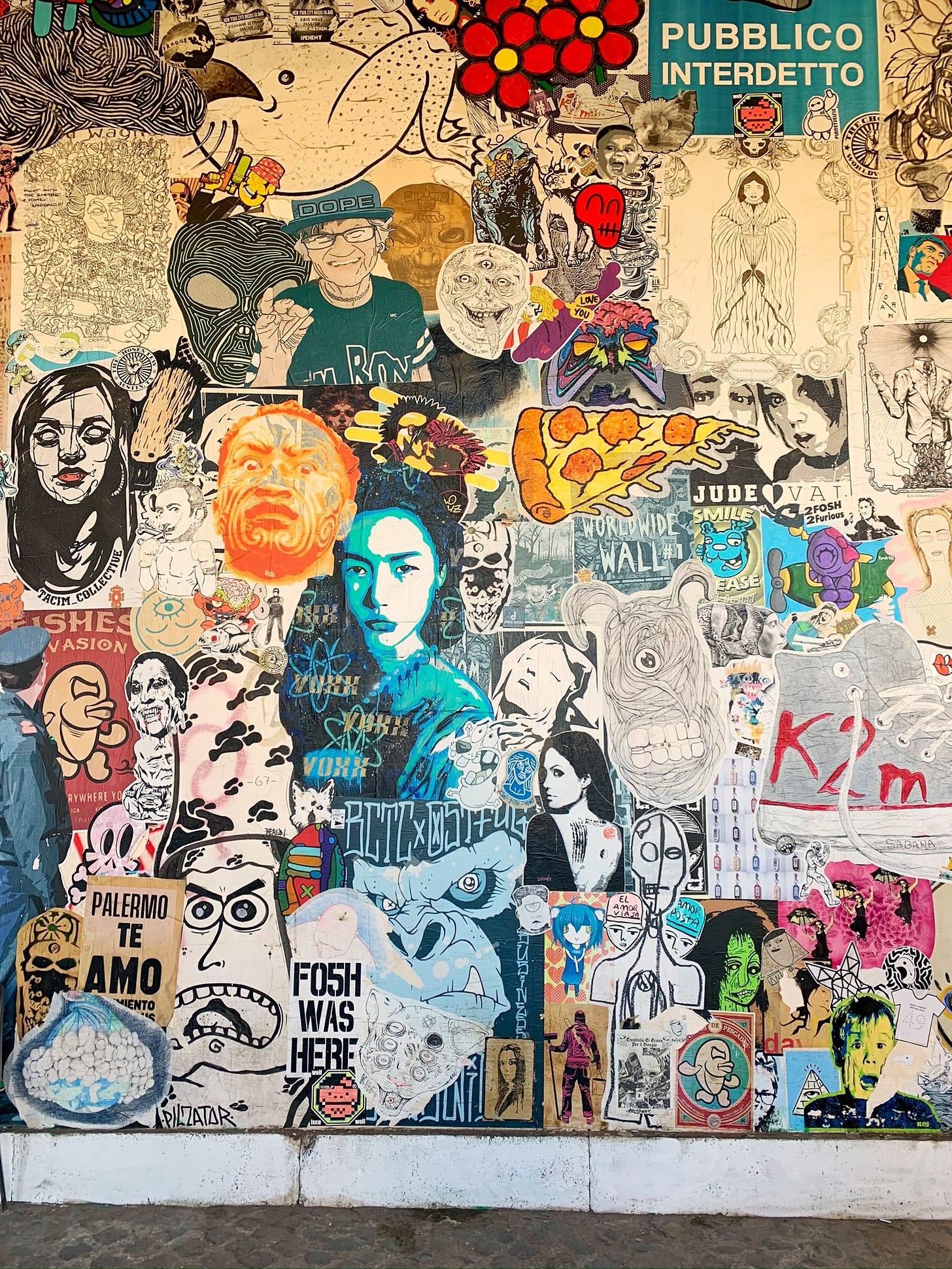
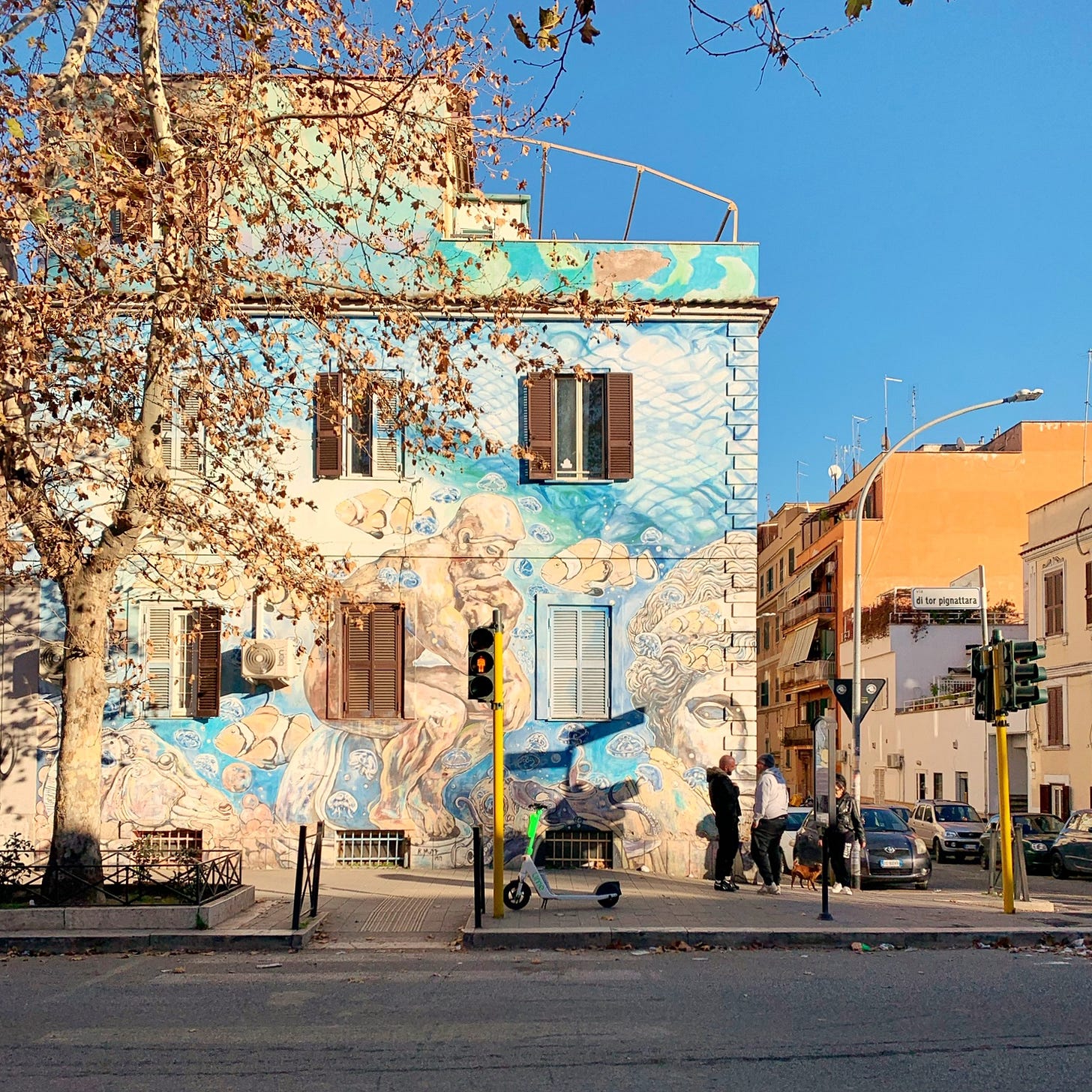
Oh wow, how cool! I am definitely booking a tour with Giulia for the next time I'm in Rome! I haven't explored any of the areas of Rome that were mentioned in the interview. What a fantastic way to see other areas of the city.
That was such a fun tour we took – Giulia is the best – and it was so great to hang out together and explore San Lorenzo. Thanks for the mention, xx